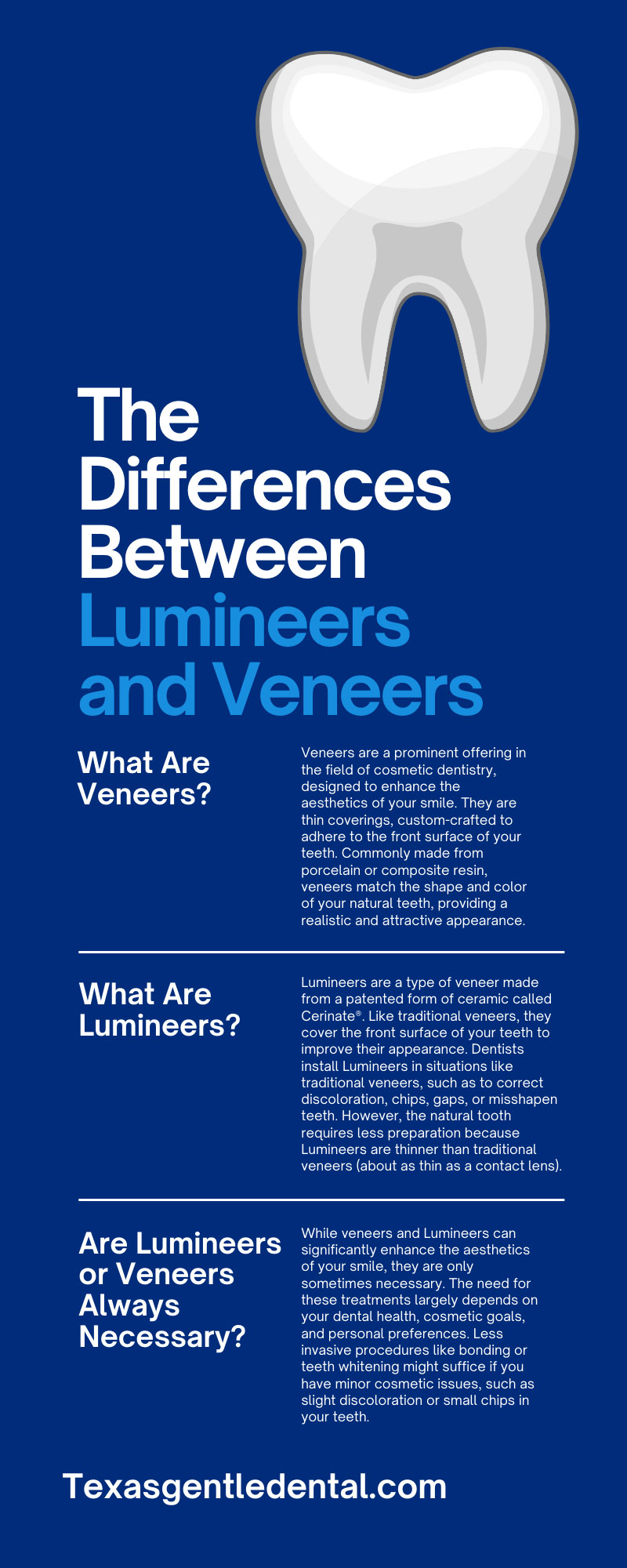The Differences Between Lumineers and Veneers

In the world of cosmetic dentistry, several options are available to enhance your smile. Among the most popular are veneers and Lumineers, both of which can transform your teeth into a picture-perfect smile. However, while they may seem similar on the surface, potential patients should understand the key differences between these two treatments.
What Are Veneers?
Veneers are a prominent offering in the field of cosmetic dentistry, designed to enhance the aesthetics of your smile. They are thin coverings, custom-crafted to adhere to the front surface of your teeth. Commonly made from porcelain or composite resin, veneers match the shape and color of your natural teeth, providing a realistic and attractive appearance.
Veneers serve multiple purposes in improving one’s smile. They are an effective solution for stubborn stains or discoloration that traditional whitening methods fail to address. Additionally, they can rectify physical damage such as chipped, broken, or worn-down teeth. Veneers also work wonders in correcting minor alignment issues or gaps between teeth without the need for braces.
The process of getting veneers is meticulous and typically spans a few appointments. Initially, your dentist prepares your teeth by removing a minuscule amount of enamel to accommodate the veneer. After, they take impressions of your teeth, which act as a blueprint for creating your custom veneers. Once they prepare the veneers, they carefully bond them to your teeth and follow this procedure with any necessary adjustments to ensure a perfect fit and a natural look.
What Are Lumineers?
Lumineers are a type of veneer made from a patented form of ceramic called Cerinate®. Like traditional veneers, they cover the front surface of your teeth to improve their appearance. Dentists install Lumineers in situations like traditional veneers, such as to correct discoloration, chips, gaps, or misshapen teeth. However, the natural tooth requires less preparation because Lumineers are thinner than traditional veneers (about as thin as a contact lens).
The procedure for getting Lumineers is like that of veneers, with a few key differences. Little to no tooth reduction is necessary because Lumineers are so thin. Also, in many cases, you do not need to wear temporary veneers while you wait for the dentist to make your Lumineers. Once they’re ready, the dentist will bond them to your teeth. This process is reversible, which is another unique feature of Lumineers.
The Pros and Cons of Each
Veneers and Lumineers both have advantages and drawbacks. One of the biggest benefits of veneers is their natural, tooth-like appearance. Porcelain veneers, in particular, are highly resistant to staining, making them a popular choice for those seeking a permanently white smile. They also offer a high degree of customization in terms of shape, color, and size, allowing your dentist to closely match them to your natural teeth or create a new look altogether.
However, veneers do come with some downsides. The procedure involves altering the structure of your natural teeth by removing some enamel, which can potentially cause sensitivity. Since this process is irreversible, you’ll always need a veneer on the treated tooth. Also, while veneers are durable, they may need replacing after 10 to 15 years, which can be a significant long-term investment.
On the other hand, Lumineers offer some unique benefits. Their ultra-thin design means that your dentist can preserve more of your natural tooth structure, often eliminating the need for temporary veneers. The process is also reversible if your original tooth structure did not require alterations. This reversibility can be an attractive feature for those who prefer a less invasive procedure or who wish to keep their options open for the future. However, because Lumineers are thinner, they may not hide darkly stained teeth as well as traditional veneers.
Are Lumineers or Veneers Always Necessary?
While veneers and Lumineers can significantly enhance the aesthetics of your smile, they are only sometimes necessary. The need for these treatments largely depends on your dental health, cosmetic goals, and personal preferences. Less invasive procedures like bonding or teeth whitening might suffice if you have minor cosmetic issues, such as slight discoloration or small chips in your teeth.
Dentists typically recommend their patients consider getting veneers or Lumineers when more significant cosmetic concerns are at play. These concerns may include severe discoloration that doesn’t respond to whitening treatments, large gaps between teeth, or substantial damage due to decay or injury. These treatments can also be a good option if you’re unhappy with the general appearance of your teeth in terms of size, shape, or alignment and desire a complete smile makeover.
However, it’s important to remember that veneers and Lumineers, while effective at addressing cosmetic issues, are not solutions for underlying oral health problems. Consulting with your dentist to identify and treat the root cause of any underlying oral health problems you may be experiencing is essential if you’re experiencing pain, sensitivity, or other signs of dental health issues. A beautiful smile is important, but so is a healthy one. In some cases, treating the underlying issue may even negate the need for veneers or Lumineers, saving you time and money.
Gentle Dental Is Here To Help
At Gentle Dental Care, we understand that a beautiful smile can significantly impact your confidence and overall well-being. That’s why our commitment to providing top-notch family cosmetic dentistry services, including veneer and Lumineer treatments, is strong. Our skilled team of dental professionals has many years of experience in these procedures, ensuring you receive the highest level of care. Our facilities have state-of-the-art technology and the tools necessary for precise, personalized treatment. We’re here to guide you through every step of the process, whether you want to correct discoloration, chipped teeth, or tooth gaps or completely transform your smile.
Understanding the key differences between Lumineers and veneers ensures you choose the right treatment plan for your health needs and cosmetic desires. As you navigate this decision, remember that our team at Gentle Dental Care is here to provide expert guidance and personalized care. We believe in empowering our patients with knowledge and providing them with comprehensive options to meet their unique dental goals. Contact our friendly team today for more information on cosmetic dentistry services.
